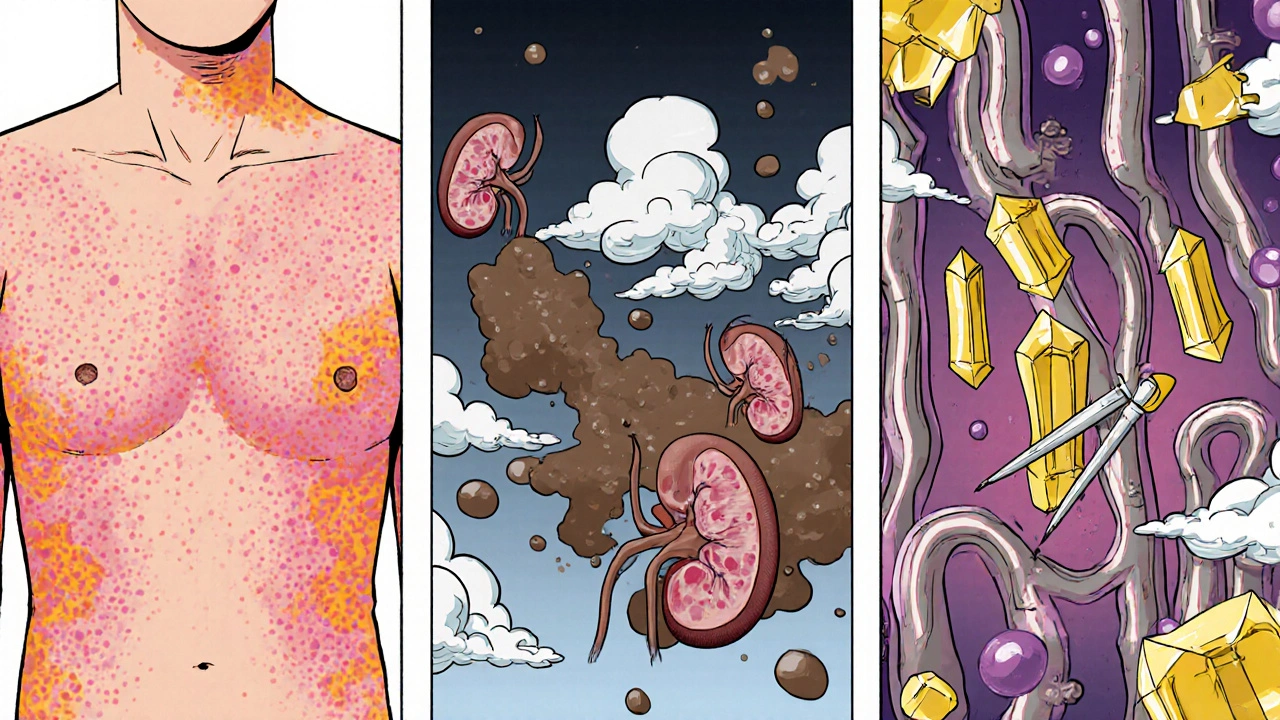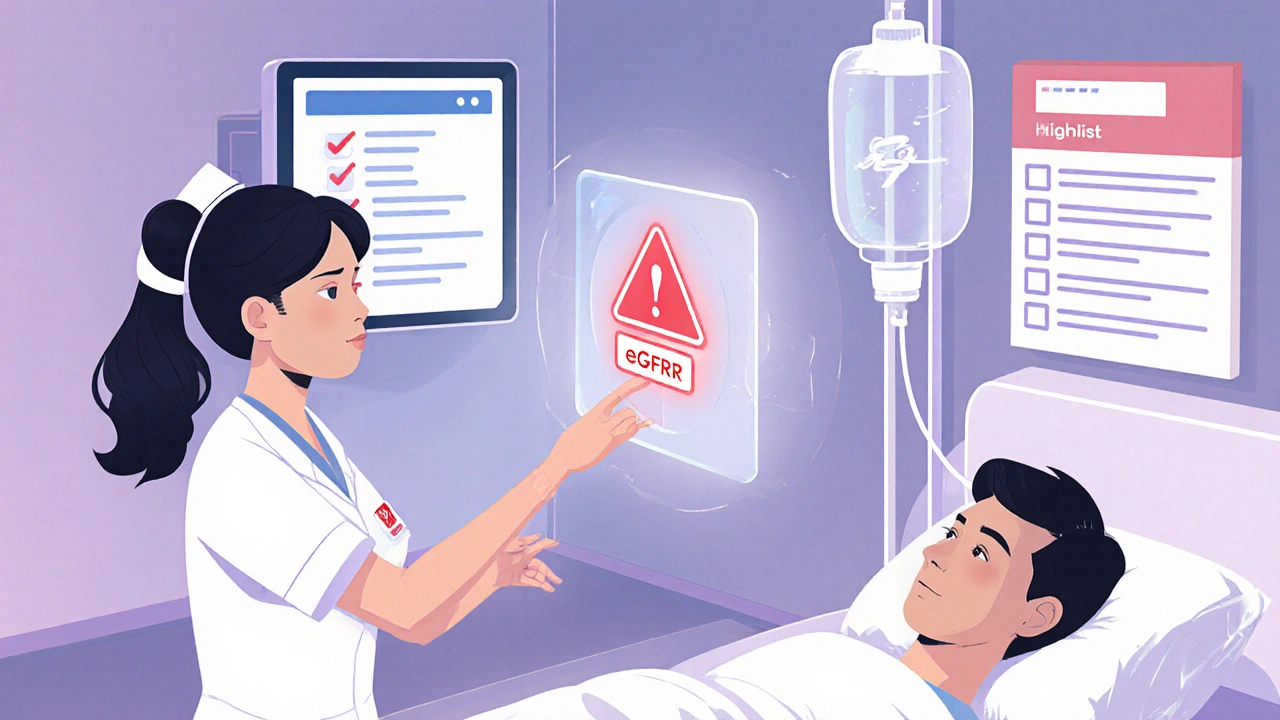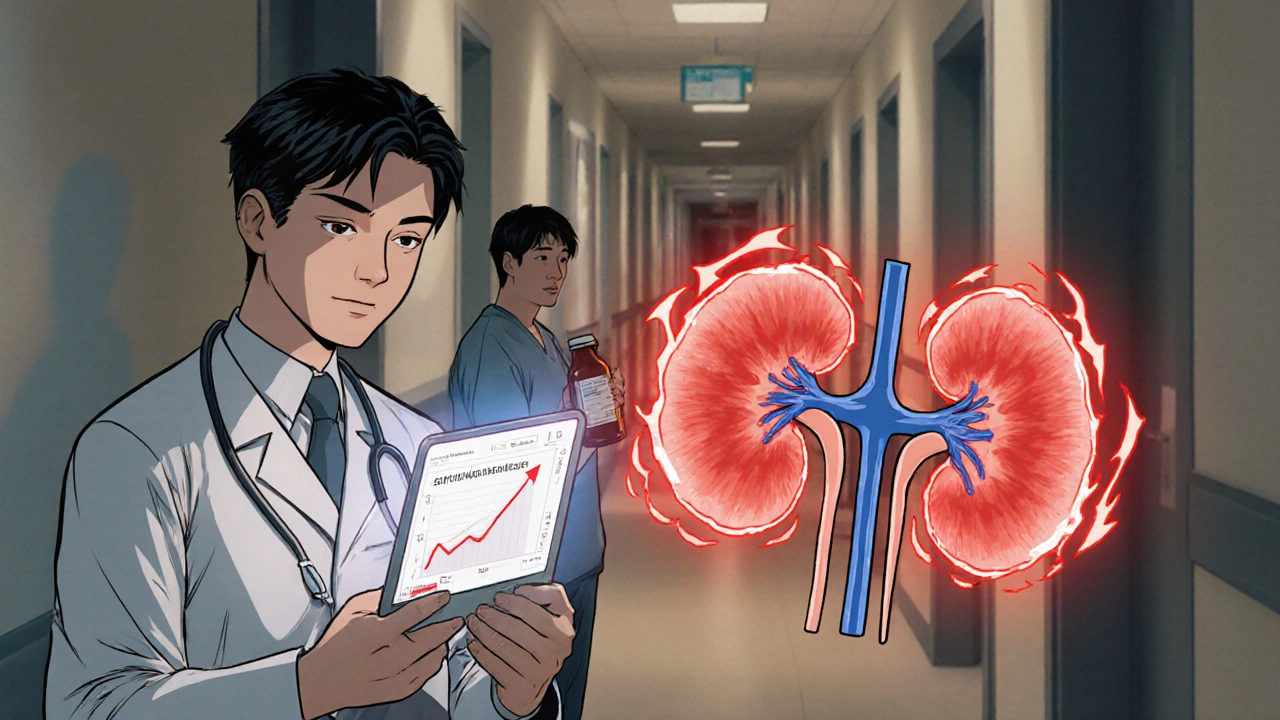Drug-Induced AKI Risk Assessment Tool
Assess Your Risk
When a medication suddenly knocks your kidneys off balance, the fallout can be swift and severe. Drug‑induced kidney failure isn’t just a lab value-it’s a life‑changing event that can be caught early if you know the red flags and the moves that keep it from happening.
What Is Drug‑Induced Acute Kidney Injury?
Drug‑Induced Acute Kidney Injury (DI‑AKI) is a rapid drop in glomerular filtration rate (GFR) that occurs within hours to days after exposure to a nephrotoxic medication. The KDIGO 2024 definition of AKI applies: an increase in serum creatinine ≥0.3 mg/dL (≥26.5 µmol/L) or a urine output <0.5 mL/kg/h for six hours.
DI‑AKI accounts for about 20 % of all hospital‑acquired AKI cases and as much as 60 % in intensive‑care units (Perazella, 2022). The good news? Roughly two‑thirds of these cases can be prevented with the right vigilance.
How Does a Drug Damage the Kidneys?
Three mechanisms dominate the landscape:
- Acute Interstitial Nephritis (AIN) - an immune‑mediated inflammation most often triggered by proton‑pump inhibitors, certain antibiotics, and NSAIDs.
- Acute Tubular Necrosis (ATN) - direct tubular cell injury caused by aminoglycosides, vancomycin, or iodinated contrast media.
- Crystal‑Induced Nephropathy - precipitation of drug crystals within the tubules, typical of acyclovir, sulfadiazine, and some protease inhibitors.
Each pathway has its own timeline, clinical clues, and prevention playbook.
Spotting DI‑AKI: Clinical Clues That Matter
Early recognition hinges on matching drug exposure to three key signals:
- Lab changes - a sudden rise in serum creatinine or a drop in urine output that fits KDIGO staging.
- Symptoms - fever, rash, and eosinophilia point to AIN; flank pain and hematuria may flag crystal nephropathy.
- Timing - AIN usually appears 7‑14 days after drug start, ATN within 24‑48 hours, and crystal injury can surface within a few hours.
Pulling a baseline eGFR using the MDRD or Cockcroft‑Gault equations before prescribing high‑risk drugs gives you the reference point you need.

Preventive Strategies That Really Work
The KDIGO 2024 consensus outlines a "three Rs" framework: reduce risk, recognize early, and respond appropriately.
Reduce Risk
- Avoid NSAIDs when eGFR <60 mL/min/1.73 m² - risk drops by ≈ 47 % (NHS Kidney Care).
- Switch high‑risk antibiotics to safer alternatives in patients with CKD.
- Limit contrast volume and use low‑osmolar agents; pre‑hydrate with isotonic saline (1 mL/kg/h for 6-12 h) based on the Mehran score.
- Alkalinize urine (pH > 7.1) when using sulfonamides or acyclovir to prevent crystal formation.
Recognize Early
- Implement automated renal dosing alerts in the EHR - studies show a 63 % cut in inappropriate dosing.
- Check serum creatinine and urine output at 24‑hour intervals for any new high‑risk medication.
- Educate patients to report sudden swelling, reduced urine, or unexplained fatigue.
Respond Appropriately
- Stop the offending drug immediately - most DI‑AKI episodes improve once the trigger is removed.
- Adjust doses of remaining meds based on the latest eGFR.
- Consider nephrology consult for Stage 2‑3 AKI or when recovery stalls after 48 hours.
Comparison of the Three Major DI‑AKI Mechanisms
| Mechanism | Typical Drugs | Onset | Lab/Clinical Clues | Prevention Focus |
|---|---|---|---|---|
| Acute Interstitial Nephritis | PPIs, NSAIDs, β‑lactam antibiotics | 7‑14 days | Fever, rash, eosinophilia, ↑ serum creatinine | Avoid offending drugs; consider steroid taper if severe |
| Acute Tubular Necrosis | Aminoglycosides, vancomycin, iodinated contrast | Within 24‑48 h | Rapid creatinine rise, muddy brown casts, oliguria | Dose‑adjust, therapeutic drug monitoring, aggressive hydration |
| Crystal‑Induced Nephropathy | Acyclovir, sulfadiazine, protease inhibitors | Hours after dose | Flank pain, hematuria, pH‑dependent crystals on microscopy | Urine alkalinization, high flow rates, dose reduction |
Tool‑Kit Checklist for Clinicians
- Obtain baseline serum creatinine and eGFR before prescribing any nephrotoxic drug.
- Use a renal dosing calculator (Cockcroft‑Gault or MDRD) for dose adjustments.
- Enable EHR alerts for the 12 high‑risk drug classes highlighted by KDIGO.
- Document urine output hourly for patients on IV vancomycin or contrast.
- Provide patients with a printed “Kidney‑Safe Med List” and clear warning signs.

Real‑World Stories: Lessons From the Front Line
John, a 68‑year‑old with stage‑3 CKD, took ibuprofen after a dental extraction. Within three days his creatinine spiked from 1.8 mg/dL to 4.2 mg/dL. The delay in linking the drug to the kidney injury added a week of hospitalization.
Contrast, on the other hand, can be safer. Mary, a 55‑year‑old undergoing coronary angiography, received a pre‑procedure isotonic saline bolus and high‑dose rosuvastatin. Her post‑procedure creatinine stayed flat, avoiding any AKI.
These anecdotes echo data: a 2023 NHS England audit showed a 60‑70 % preventability rate for DI‑AKI when systematic protocols are followed.
Future Directions: AI, Biomarkers, and Personalized Dosing
The FDA’s 2024 clearance of an AI‑driven decision‑support tool (Dosis Health) cut DI‑AKI events by 41 % in a multicenter trial. Parallel research is testing urinary biomarkers like TIMP‑2·IGFBP7 to flag injury before creatinine rises.
Genetic profiling may soon guide drug selection for patients with known susceptibilities (e.g., APOL1 variants affecting NSAID tolerance). Telehealth platforms are also piloting daily eGFR reporting for high‑risk outpatients.
Bottom Line: Turn Prevention Into Routine
When you treat a patient-or yourself-with a drug that can hurt the kidneys, think of three simple steps: check the baseline, choose the safest option, and monitor like a hawk. The payoff isn’t just a better lab result; it’s fewer hospital stays, lower costs, and a healthier life.
What are the most common drugs that cause DI‑AKI?
NSAIDs, aminoglycosides (e.g., gentamicin), vancomycin, iodinated contrast agents, and certain antibiotics like β‑lactams are the top culprits. Sulfonamides and antiviral agents can trigger crystal‑induced injury, especially when hydration is inadequate.
How quickly should kidney function be checked after starting a high‑risk medication?
A baseline measurement is essential before the drug begins. For most high‑risk agents, repeat serum creatinine and urine output at 24 hours, then again at 48 hours. Adjust the schedule if the patient shows symptoms or already has CKD.
Can DI‑AKI be reversed?
Yes, in many cases stopping the offending drug and providing supportive care (hydration, dose adjustment) leads to full recovery, especially for AIN and crystal nephropathy. ATN may take longer, and some patients progress to chronic kidney disease if injury is severe.
What role do electronic alerts play in preventing DI‑AKI?
Clinical decision support systems flag high‑risk drugs when eGFR is low. Studies report a 63 % drop in inappropriate dosing and a 41 % reduction in DI‑AKI incidents when these alerts are active.
Is there a cost difference between preventing and treating DI‑AKI?
Preventive measures (baseline labs, hydration protocols) cost a few hundred dollars per admission, while treating DI‑AKI averages $18,450 per episode in the U.S. Prevention is clearly the cheaper, safer route.


5 Comments
Nephrotoxic meds can trigger AKI via tubular injury mechanisms.
It's crucial to monitor serum creatinine and urine output closely when starting high‑risk drugs. Keeping an eye on baseline labs and adjusting dosing can prevent the cascade of injury. If you notice a rise of 0.3 mg/dL within 48 hours, consider halting the offending agent and consulting nephrology early.
Wow, drug‑induced AKI is a real beast, isn’t it?! When you see those red flags-like a sudden creatinine spike or oliguria-jump on it immediately!!! Remember, early detection is the game‑changer; the kidneys love a quick intervention. Also, stay hydrated, review the medication list for NSAIDs or aminoglycosides, and flag any nephrotoxins for the prescribing team. You’ve got this, and your patients will thank you for the vigilance! 😊
Good points. Also check for drug interactions that can worsen kidney function.
Think of kidney health like a garden-if you water too much or use harsh chemicals, the plants suffer. Choosing gentle meds is like using organic fertilizer; it nurtures without burning the roots.
Write a comment